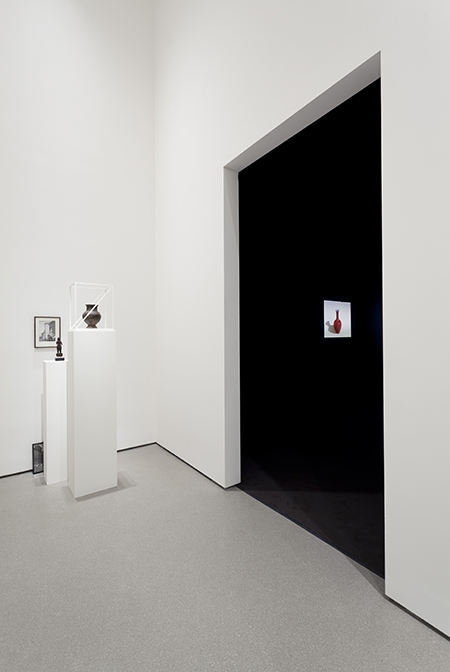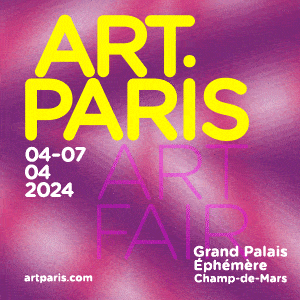Whitehot Magazine
April 2024
"The Best Art In The World"
"The Best Art In The World"
April 2024
February 2012: Haris Epaminonda @ The Museum of Modern Art
 Installation view of the exhibition Projects 96: Haris Epaminonda. November 17, 2011 through February 20, 2012.
Installation view of the exhibition Projects 96: Haris Epaminonda. November 17, 2011 through February 20, 2012.
Photographer: Jonathan Muzikar. Image courtesy of The Museum of Modern Art
Projects 96: Haris Epaminonda
The Museum of Modern Art
November 17, 2011–February 20, 2012
Projects Gallery, second floor
Projects 96: Haris Epaminonda is a peculiar show in the Projects wing of the MoMA. It’s a multimedia installation consisting of photographs, pottery and three video projections. The viewer enters the exhibition through a narrow hallway that doubles over itself and then spills into a large room. On the walls of the hallway are small photographs with a noticeable pattern: they feature people looking at artwork. A man in a suit holds a clipboard and examines a nude statue. A woman in a red dress stands at a Greek ruin and looks at an enormous crumbling sculpture of a face and hands. The dated clothing of the people places the photos in the 1950’s. In addition to the photographs, small antique urns from different cultures and time periods stand on wooden platforms that are painted white. The urns are solid colored— red, teal, seafoam—and match the backgrounds in the photographs.
The viewer discovers more oddities as they enter the main room, including a tall octagonal pillar with nothing on top of it, as well as a miniature flight of stairs that ends at waist height. Above the miniature stairs, a small niche is cut into the wall that contains an urn. Most puzzling is a tall rectangular stand with a bronze urn on top. A container made of thin strips of wood, similar to the frame of a house, encloses the urn. On the floor, propped against the wall and partially obscured by the stand, lies a stash of framed photographs. It looks as if the art handlers tucked them there while hanging the show and then forgot about them.
 Haris Epaminonda. Untitled T5 from Vol. VII. 2011. Found printed paper, 11 7/8 x 9 11/16 x 1 in.
Haris Epaminonda. Untitled T5 from Vol. VII. 2011. Found printed paper, 11 7/8 x 9 11/16 x 1 in.
Courtesy the artist and Rodeo, Istanbul.
Epaminonda’s motivations are mysterious, however it’s clear that her pieces are tied together in aesthetic—the vintage photographs share a matching color palette and depict images of crumbling artwork and architecture from lost civilizations. A palpable atmosphere is felt in the exhibition—it’s a bit like walking into an old library and sensing the history contained in the old books. The artist continues to create interesting juxtapositions in the final room of the exhibition. Three videos are projected onto separate walls, inviting the viewer to stand in the dark surrounded by them. As the viewer watches a video in front of them, a second plays to their right and a third plays directly behind them. While each video is different, the three films are unified by a soundtrack that plays over the speakers: a triumphant soundscape of strings and shakers composed by the band Part Wild Horses Mane On Both Sides.
The first video is a slideshow of archaeological sites. A building on the edge of a cliff displays for a few minutes and then switches to a cracked courtyard beside stone pillars. On the next wall, the second video rotates between close-ups of statues, idols, and urns similar to the ones in the main exhibition. The image slightly shakes as if the camera was rattled by the wind. When one of the images suddenly slides off the screen and a turning page is seen, it’s revealed that the artworks are actually photographs filmed out of a book with a camcorder. The third video depicts a landscape of a palm tree standing before a blue sky. The image shakes as a result of the camcorder, but never changes to a different page. This simple landscape is possibly the most intriguing in Epaminonda’s show—it’s the only one of her images that doesn’t allude to decay, instead remaining new and implacable in any time period. One is inclined to stare at it for a long time. In fact, it’s difficult to look away. When absorbed in the image, it’s as if time has stopped.
 Installation view of the exhibition Projects 96: Haris Epaminonda.
Installation view of the exhibition Projects 96: Haris Epaminonda.
Photographer: Jonathan Muzikar. Image courtesy of The Museum of Modern Art

Dan Tarnowski
Dan Tarnowski has published reviews of culture, and several chapbooks of his poetry. He lives in Brooklyn.
view all articles from this author







